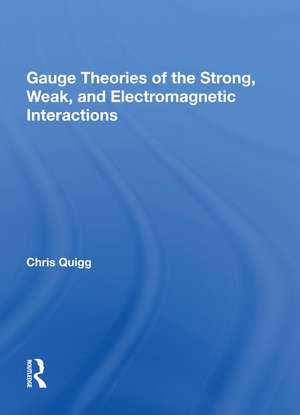Gauge Theories Of Strong, Weak, And Electromagnetic Interactions
Autor Chris Quiggen Limba Engleză Paperback – 13 iun 2023
Preț: 251.28 lei
Preț vechi: 298.35 lei
-16% Nou
Puncte Express: 377
Preț estimativ în valută:
48.11€ • 49.63$ • 39.88£
48.11€ • 49.63$ • 39.88£
Carte tipărită la comandă
Livrare economică 20 februarie-06 martie
Preluare comenzi: 021 569.72.76
Specificații
ISBN-13: 9780367154981
ISBN-10: 0367154986
Pagini: 350
Dimensiuni: 165 x 228 mm
Greutate: 0.64 kg
Ediția:1
Editura: CRC Press
Colecția CRC Press
ISBN-10: 0367154986
Pagini: 350
Dimensiuni: 165 x 228 mm
Greutate: 0.64 kg
Ediția:1
Editura: CRC Press
Colecția CRC Press
Cuprins
Preface xi One Introduction 1 1.1 Elements of the Standard Model of Particle Physics 4 1.2 Leptons 6 1.3 Quarks 7 1.4 The Fundamental Interactions 15 Problems 18 For Further Reading 21 References 23 Two Lagrangian Formalism and Conservation Laws 25 2.1 Hamilton's Principle 26 2.2 Free Field Theory Examples 28 2.3 Symmetries and Conservation Laws 30 Problems 33 For Further Reading 35 References 37 Three The Idea of Gauge Invariance 38 3.1 Historical Preliminaries 38 3.2 Gauge Invariance in Classical Electrodynamics 40 3.3 Phase Invariance in Quantum Mechanics 42 3.4 Significance of Potentials in Quantum Theory 44 3.5 Phase Invariance in Field Theory 46 3.6 Feynman Rules for Electromagnetism 50 Problems 52 For Further Reading 53 References 56 Four Non-Abelian Gauge Theories 57 4.1 Motivation 57 4.2 Construction 58 4.3 Some Physical Consequences 63 4.4 Assessment 66 Problems 66 For Further Reading 69 References 70 Five Hidden Symmetries 71 5.1 The Idea of Spontaneously Broken Symmetries 72 5.2 Spontaneous Breaking of Continuous Symmetries 76 5.3 Spontaneous Breaking of a Gauge Symmetry 78 5.4 The Sigma Model 81 5.5 Spontaneous Breaking of a Non-Abelian Symmetry 86 5.6 Prospects 87 Problems 88 For Further Reading 91 References 94 Six Electroweak Interactions of Leptons 95 6.1 An Effective Lagrangian for the Weak Interactions 96 6.2 Intermediate Vector Bosons: A First Look 110 6.3 The Standard Electroweak Theory of Leptons 120 6.4 Neutral-Current Interactions among Leptons 135 6.5 The Higgs Boson: A First Look 146 6.6 The Higgs Boson, Asymptotic Behavior, and the 1-TeV Scale 151 6.7 Neutrino Mixing and Neutrino Mass 156 6.8 Renormalizability of the Theory 166 6.9 Interim Assessment 170 Problems 171 For Further Reading 177 References 183 Seven Electroweak Interactions of Quarks 187 7.1 The Standard Electroweak Theory: Preliminaries 188 7.2 Electroweak Gauge Bosons 194 7.3 Electron-Positron Annihilations 198 7.4 Deeply Inelastic Lepton-Hadron Scattering 205 7.5 Hadron-Hadron Interactions 223 7.6 Further Tests of the Electroweak Theory 229 7.7 A Brief Look at Quantum Corrections 231 7.8 The Scale of Fermion Masses 236 7.9 Search for the Higgs Boson 237 7.10 Incompleteness of the Electroweak Theory 241 7.11 The Hierarchy Problem 244 7.12 The Vacuum Energy Problem 246 7.13 Reflections 247 Problems 249 For Further Reading 258 References 263 Eight Strong Interactions among Quarks 269 8.1 A Color Gauge Theory 270 8.2 Charge Renormalization in Electrodynamics 281 8.3 The Running Coupling Constant in QCD 294 8.4 Perturbative QCD: A First Example 303 8.5 QCD Corrections to Deeply Inelastic Scattering 308 8.6 Jets in Hadron-Hadron Collisions 325 8.7 Two-Photon Processes and the Photon-Structure Function 328 8.8 Color Confinement 336 8.9 QCD-induced Electroweak Symmetry Breaking 341 8.10 The 1/N Expansion 345 8.11 Strong-Interaction Symmetries 352 8.12 Assessment 356 Problems 358 For Further Reading 369 References 381 Nine Unified Theories 387 9.1 Why Unify? 389 9.2 The SU(5) Model 391 9.3 Coupling-Constant Unification 402 9.4 Nucleon Decay 408 9.5 The Baryon Number of the Universe 410 9.6 The Problem of Fermion Masses 414 9.7 Assessment 416 Problems 418 For Further Reading 423 References 427 Epilogue 430 Appendix A Notations and Conventions 433 A.1 Four-Vectors and Scalar Product 433 A.2 Dirac Matrices 434 A.3 Trace Theorems and Tensor Contractions 436 A.4 Dirac Equation and Dirac Spinors 437 A.5 Color Algebra 440 A.6 Weyl-van der Waerden Spinors 444 References 445 Appendix B Observables and Feynman Rules 447 B.1 Phase-Space Formulas: Decay Rates and Cross Sections 447 B.2 Feynman Rules: Generalities 448 B.3 Feynman Integrals 450 B.4 Regularization Procedures 452 B.5 Feynman Rules: Electrodynamics 453 For Further Reading 454 References 456 Appendix C Physical Constants 457 For Further Reading 457 Author Index 459 Subject Index 475
Notă biografică
Chris Quigg is a member of the Theoretical Physics Department of the Fermi National Accelerator Laboratory. He received the American Physical Society's 2011 J. J. Sakurai Prize for outstanding achievement in particle theory.
Descriere
This monograph presents a coherent and elementary introduction to Gauge theories of the fundamental interactions and their applications to high-energy physics. It deals with the logic and structure of local Gauge symmetries and Gauge theories, from quantum electrodynamics through unified theories of the interactions among leptons and quarks. Many explicit calculations provide the reader with practice in computing the consequences of these theories and offer a perspective on key experimental investigations. First published in 1983, this text is ideal for a one-semester course on Gauge theories and particle physics. Specialists in particle physics and others who wish to understand the basic ideas of Gauge theories will find it useful as a reference and for self-study.
